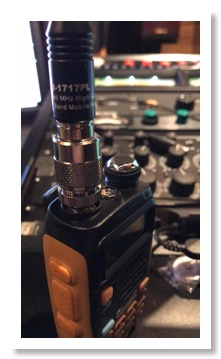02 Getting your FCC Tech license
01/01/99 23:16
First off - Set yourself up for success. Get your FRN number from the FCC. You’re going to need it.
https://www.fcc.gov/rofrn
Now take the test, pass it and get on the air! Success!!!
But if you’re having any issues, there are a zillion places to go for help. Here’s my story —

Side-note — I wanted to get my license when I was a kid but I had trouble hearing CW (Morse Code). I could tap it out fine, I could read it off paper, but I could never hit the FCC required speed. So, I gave up the idea. It was during these nets and rag-chews on the local repeaters that I found out that the FCC had dropped the CW requirement some years back. So, GET the radio and LEARN TO PROGRAM AND OPERATE the radio. Don’t wait. Start listening. You’ll learn a lot. Just don’t key up before you get your license, of course.
Anyway - I started looking for what to do to study for the exam. My favorite “practice exam” site turned out to be HamStudy.org — It’s free, it keeps track of your progress, it shows mnemonics and tips for memorizing many answers and how to pick out some of the “throw away” answers on the (multiple choice) exam. You have access to the entire pool of questions - the test is compromised of 35 of those questions. If I recall, you can miss 7 and pass.
So I started taking practice exams and quickly realized that I wasn’t quite up to the task. Frankly, I didn’t want to drop ($25?) on the ARRL handbook, so I started searching for options. KB6NU’s No Nonsense Tech Study Guide. A free PDF. It was a no-brainer. And videos — I learn better from “lectures” than reading. Dave Casler (KEØOG) made a great series of videos that covered almost the entire Tech course.

Ready for the test? Good. Either go to your local radio club or check out the “Find a Session” link at HamStudy.org and sign up for one online. When I got my Tech, they were just starting online testing (COVID had put in-person testing pretty much on hold everywhere). I signed up with one of the WB5QNG / W5YI-VEC sessions, got a PIN number and waited.
They e-mailed me to pay the exam fee (I think it was $15, which is typical) and gave me a time slot. 7PM was all mine. Zoom session on my laptop. Had to show the space was free of distractions and other people, books and materials, etc. A line of 5 proctors on the side of my screen making sure I wasn’t looking around or asking anyone anything. Didn’t need to - because I was pretty well prepared. Nailed the test, filled out a form or two and around 6 hours later, I found my fresh new callsign on the FCC database.
Following up with the General Class license was more of the same — Ham Radio 2.0’s General Class playlist and more HamStudy.org — Quite a bit more. Currently “sort of” studying for the Extra - but I think that may take a little time. We’ll see how it goes.
NOTE: Originally posted in September of 2020 — Blog post date has been tweaked to force position in listing.
